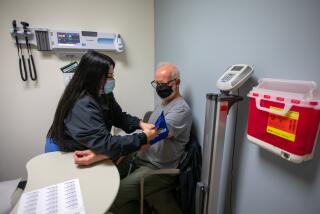Patient care by the numbers
- Share via
We were at the end of our visit. I’d done a full history and physical exam on this 42-year-old woman. We’d reviewed the status of her diabetes, checked her blood pressure, adjusted her three diabetes medicines, reviewed her cholesterol levels, written out all the prescriptions, arranged appointments for the eye doctor and the nutritionist.
Every few minutes I turned from her to the computer to type notes of our conversation so that I’d have appropriate documentation of our visit together. I’d checked to see how her kids were doing and how things were at work. Now we had two minutes left of our 15-minute visit to review “health maintenance.” I quickly checked the status of her vaccinations, the date of her last Pap smear, discussed the importance of regular exercise, use of sunscreen, eating lots of fruits and vegetables. Now there was one minute left.
That’s when she asked: “What about a mammogram?”
Recently a memo was sent to all of the physicians in our department by a hospital administrator, a doctor who’d recently taken on a new role. The memo reminded us that mammograms were one of the “performance indicators” that regulatory agencies use to monitor our hospital’s quality of care. “We realize that the controversial data regarding mammograms for women aged 40-50 are not resolved,” the memo said. “However, we urge you to order this important screening test for all your patients over the age of 40.”
*
Keeping up with the literature
In the academic medical setting, “evidence-based medicine” is practically a mantra. In my medical center we doctors like to consider ourselves academics. Much of our time is devoted to teaching medical students and residents. Self-education -- keeping up with the current medical literature -- is a priority and weekly educational conferences are a must.
We pride ourselves in thinking very carefully before ordering certain tests or giving particular medications, debating whether the scientific data truly support it. We eschew drug company gifts and free samples, trying to be objective and to base our decisions on hard data and the needs of our individual patients.
In the last two years there has been much discussion about mammograms. The benefits for women 50 and older have been fairly strongly supported by the medical literature, though there certainly have been some hotly debated challenges. But the data for women ages 40 to 49 are controversial. Studies have offered conflicting evidence as to whether this screening test is beneficial, neutral or perhaps even harmful.
I looked at my patient and wondered if, in the remaining minute of our time, I could do justice to this complicated issue. Could I adequately explain her risk? Could I explain that the oft-mentioned 1-in-8 number is really a lifetime cumulative risk of breast cancer that applies only to women in their 80s who haven’t died of anything else? The statistic for women in their 40s is closer to 1 in 67. For women in their 50s, one life will be saved for every 2,500 mammograms. But for women in their 40s, it can take 5,000 to 10,000 mammograms to save a life. And for those women in their 40s, there will be many “false positives”: unnecessary biopsies with their attendant cost, risks and anxiety. Could I explain all that in one minute?
My patient was waiting for an answer. If I wanted to offer her true informed consent, I’d need much more time to explain these subtle, but critical, details. The doctors on our faculty spend hours analyzing the evidence, dissecting the minutiae of each clinical trial, and even we can’t come to an agreement. How was I supposed to summarize this in one minute for her?
Then I thought back to the memo, how we are being judged by the number of mammograms we order. When that memo arrived, it outraged many of us. How could an administrator say, to a group of educated academic physicians, “The evidence for this test isn’t clear, but please do it anyway”? What chutzpah! But in some ways, adhering to the memo would actually represent the easiest choice. I would just order the mammogram, not worrying about a protracted discussion, and I’d satisfy the administrators.
Evidence-based medicine is a complicated issue. Meant to ensure more rigorous and consistent science, it often induces more confusion than clarity. In some ways, evidence-based medicine is more about treating populations than individual people. If it takes 5,000 mammograms to save one life, then the value of mammograms depends on who you ask. For that one person whose life was saved, the mammogram was nothing short of the messiah. For the other 4,999, it didn’t change much in their lives, and maybe it was an annoyance or an unnecessary expense. And then there will be a few people who were actually harmed in some way by the procedure.
*
Patients as data
For administrators, evidence-based medicine means something entirely different from how doctors or patients view it. Administrators deal with patients as data -- number of visits per year, percentage who get a Pap smear, numbers of admissions for chest pain or pneumonia. Numbers are clean and can be arranged and rearranged. They can be erased and recalculated at will.
Patients and patient care, on the other hand, are inherently messy. Despite the advances in medical research, much of the doctor-patient encounter is profoundly non-quantitative, with nary a shred of scientific evidence. There are fears, concerns, language barriers, cultural barriers, misunderstandings, hidden agendas. Sometimes what a patient most needs to address isn’t even listed in the choice of “diagnosis codes.” For the practicing physician, patient care can be frustrating, time-consuming, gratifying, even elating at times. But it is always real.
And so I looked back at my patient. I smiled and sighed. I told her that the evidence was not entirely clear as to whether mammograms were beneficial for women in their 40s. But it is clear, I reminded her, that controlling diabetes is absolutely beneficial.
She decided she wanted a mammogram. I told her it was a fine idea, as long as she realized that the mammogram was an imperfect test, that “positive” results didn’t necessarily mean cancer and that “negative” results didn’t necessarily give her a clean bill of health. We were already running past our minute, and I knew other patients were waiting.
I hoped I’d given my patient a reasonably fair assessment of the evidence. I was also aware that somewhere in the morass of administration, someone would be checking off a box on my “performance indicator” that I’d ordered a mammogram. But had she decided against having one, my performance indicator would have been penalized, suggesting that I was not offering the highest level of care. Our conversation about the mammogram would not count, no matter how much we had discussed the risks and benefits.
After my patient left, I typed in all the details of our discussion to ensure that my documentation would be complete, given the new regulations about medical records. That would put me only a little further behind schedule.
*
Danielle Ofri is an internist in New York City, editor of the Bellevue Literary Review and author of “Singular Intimacies: Becoming a Doctor at Bellevue” (Penguin Books, 2004).






